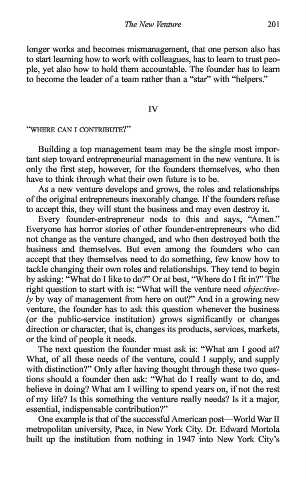Page 208 - ENTREPRENEURSHIP Innovation and entrepreneurship
P. 208
53231_Innovation and Entrepreneurship.qxd 11/8/2002 10:50 AM Page 201
The New Venture 201
longer works and becomes mismanagement, that one person also has
to start learning how to work with colleagues, has to learn to trust peo-
ple, yet also how to hold them accountable. The founder has to learn
to become the leader of a team rather than a “star” with “helpers.”
IV
“WHERE CAN I CONTRIBUTE?”
Building a top management team may be the single most impor-
tant step toward entrepreneurial management in the new venture. It is
only the first step, however, for the founders themselves, who then
have to think through what their own future is to be.
As a new venture develops and grows, the roles and relationships
of the original entrepreneurs inexorably change. If the founders refuse
to accept this, they will stunt the business and may even destroy it.
Every founder-entrepreneur nods to this and says, “Amen.”
Everyone has horror stories of other founder-entrepreneurs who did
not change as the venture changed, and who then destroyed both the
business and themselves. But even among the founders who can
accept that they themselves need to do something, few know how to
tackle changing their own roles and relationships. They tend to begin
by asking: “What do I like to do?” Or at best, “Where do I fit in?” The
right question to start with is: “What will the venture need objective-
ly by way of management from here on out?” And in a growing new
venture, the founder has to ask this question whenever the business
(or the public-service institution) grows significantly or changes
direction or character, that is, changes its products, services, markets,
or the kind of people it needs.
The next question the founder must ask is: “What am I good at?
What, of all these needs of the venture, could I supply, and supply
with distinction?” Only after having thought through these two ques-
tions should a founder then ask: “What do I really want to do, and
believe in doing? What am I willing to spend years on, if not the rest
of my life? Is this something the venture really needs? Is it a major,
essential, indispensable contribution?”
One example is that of the successful American post—World War II
metropolitan university, Pace, in New York City. Dr. Edward Mortola
built up the institution from nothing in 1947 into New York City’s

